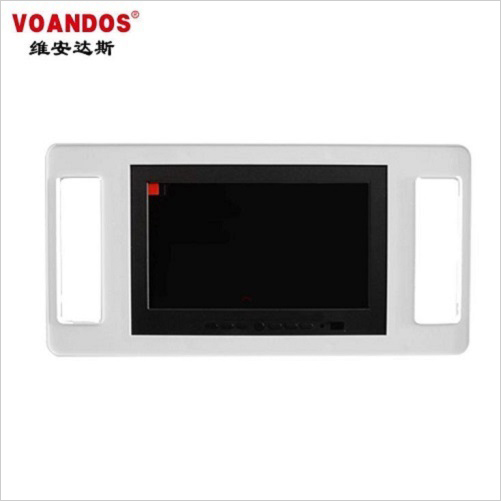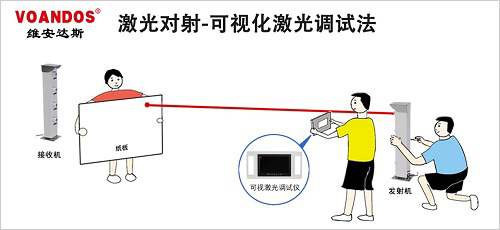Because of its good stability, long detection range and zero false positives, laser-based detectors are increasingly favored by users in the field of security intrusion detectors and special-purpose detectors. In order to achieve invisible prevention of the target area, most lasers The invisible laser is used as the light source of the laser beam detector.

Invisible laser can be used to achieve invisible prevention, which makes it difficult for intruders to evade, thus achieving the purpose of accurate alarm and crime prevention. However, using invisible laser as the detector light source will bring another confusion to the user, that is Align the problem of debugging. At present, invisible laser detectors on the market use a handheld laser finder (laser locator) to determine the position of the laser beam. The working principle of the laser finder (laser locator) is that the laser finder has a receiving window that can receive the spectrum emitted by the laser transmitter, and the receiving window of the finder receives the laser emitted by the laser transmitter. When the ray is emitted, the finder will give an audible and visual indication; the stronger the laser energy received by the finder, the higher the cues will be, and the more the corresponding indicator group will be brighter. The user uses the working characteristics of the laser finder to find the approximate position of the beam of the laser transmitter through the laser finder during the installation and debugging of the laser detector, and cooperate with the beam angle adjustment of the laser transmitter to provide the laser transmitter. The emitted laser beam is roughly adjusted to the receiving window position of the laser receiver to realize the alignment debugging of the laser detector. Since the laser beam is relatively small, it is difficult to find the beam signal, so the debugging method is particularly inefficient.
Although the laser is highly concentrated, the beam will diffuse at a certain angle as the distance increases. The farther the detection distance is, the larger the beam spreads. The laser finder can only sense the presence of laser energy at a certain position, but cannot accurately determine the center position of the laser's optical axis. Therefore, the laser finder can only help the user to find the laser beam emitted by the laser transmitter. The approximate location helps the user to achieve a general alignment of the laser beam, which does not help the user to achieve precise alignment of the laser beam, which is like a scorpion image; because the laser beam of the laser transmitter and the laser receiver can not be correspondingly received The precise alignment of the window, due to environmental influences and thermal expansion and contraction during the use of the laser beam, the laser beam will slowly move within a certain range, and the laser receiver may not receive the transmitter due to the movement of the beam. When the beam signal is emitted, the laser detector will have a false alarm. At this time, the user needs to re-shoot the beam alignment; or the user debugs when the weather is good, and the receiver prompts that the signal is normal, but receives it at this time. The signal received by the machine is actually the edge of the laser beam signal, the signal is weak, when there is heavy fog or heavy rain, etc. When the gas is received, the beam signal received by the laser receiver is not the focus center signal of the laser beam. At this time, the beam signal is easily attenuated by the rain fog, and the receiver may not receive the beam signal, forming a false alarm, thus giving the user a There are many inconveniences and confusions in using it.
Therefore, how to solve the problem that the invisible laser detector is difficult to achieve precise alignment by means of technical means or the development of a certain tool is a problem that the laser intrusion detector manufacturer or the vast majority of colleagues in the field of laser electronics urgently need to solve.
As an original national brand focusing on high-end intrusion detection and alarm system, Viandas has 16 years of experience in R&D and production of laser detectors. Facing the problem of low efficiency of laser beam-to-shoot debugging, the company's technical team constantly explored and finally invented. A visual laser debugger that can precisely align the invisible laser transmitter and receiver of the laser beam, which has obtained the national invention patent.

The Viandas Visual Laser Debugger is a handheld portable structure that can also be connected to a tripod. It has a built-in large-capacity rechargeable lithium battery pack and a 7-inch TFT high-resolution LCD display. It can be used continuously for more than 7 hours on a single charge.

The Viandas visual laser debugger can help users to observe the position of the beam emitted by the laser-transmitted laser transmitter during the installation, debugging or maintenance of the laser intrusion detector. It is possible to observe whether the invisible laser is in sight. Accurately aligning the receiving window of the laser receiver helps the user to easily solve the problem of precise alignment of the laser transmitter and the laser receiver during installation, debugging and maintenance, and improve the efficiency and accuracy of laser intrusion detector installation and debugging. Sexuality prevents false positives that may be caused by laser intrusion detectors due to inability to achieve precise focus; portable, visual, accurate, and efficient.
Machinery Castings,Pump Casting,Fuel Pump Casting,Hydraulic Pump Casting
Jiangsu Minnuo Group Co.,Ltd , https://www.cnmn-group.com
![<?echo $_SERVER['SERVER_NAME'];?>](/template/twentyseventeen/skin/images/header.jpg)